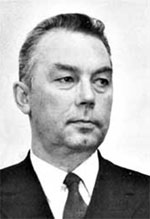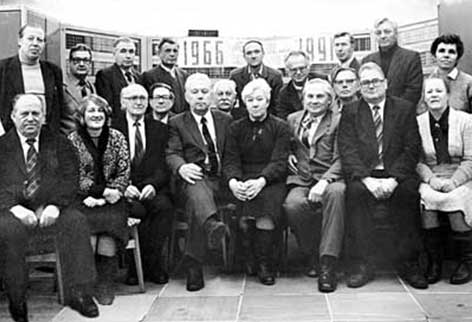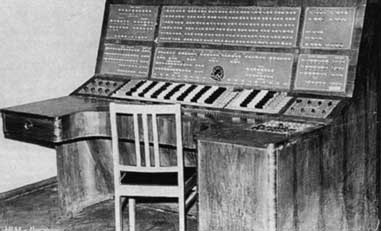Anatoliy Nikolaevich Myamlin
Home → Hall of Fame → Anatoliy Nikolaevich Myamlin
Famous computer designer, professor, doctor of technical sciences.
Edition and translation: Alexander Nitusov
Anatoliy Nikolaevich Myamlin was born in April 1925 into the family of a railway official in town of Saratov (on Volga ). By the beginning of the war he had finished eight classes of a secondary school. From January 1942 till September 1945 he was working at the aircraft plant doing repairing work and mounting electrical equipment. The work was very hard it lasted 12 -16 hours a day without free days.

Myamlin Anatoliy Nikolaevich
Since September 1945 Myamlin studied at the faculty of physics at the University of Saratov . He graduated in 1950 with diploma of engineer on “radio-electronics”. After graduation he was appointed to the Leningrad Institute of Physics and Technologies (now Institute of Atom Energy ) into laboratory of academician A.L. Mints. There he was engaged into design of an installation analysing composition of radioactive elements in testing samples obtained from ionisation chambers. The device, which incorporated more than 200 electron tubes, was successfully tested and put in operation in 1951. In fact it was his first computer related project, since the device included an electronic differential analyser.
In 1952 he received a new appointment . That time it was a scientific enterprise in town of Dubna (about 150 km from Moscow ), the famous Joint Institute of Nuclear Researches (partner of the European CERN), where he was engaged in design of new instruments for experiments in nuclear physics. Myamlin had to reside in Dubna alone because his wife a post-graduate of the Moscow State University was busy preparing a dissertation thesis and therefore stayed in Moscow with their one-year-old daughter. No wonder that having completed the project Myamlin applied for transferring to Moscow , where he received a position at the Mathematical Institute of the USSR Academy of Sciences (AS USSR).
Department of the applied mathematics where he worked was headed by academician M.V. Keldysh (future president of the AS USSR). In reality the department had become practically separate academic institute with its own research program already by 1953. Among its numerous tasks there was number of problems directly aimed at the space researches, what caused urgent need in modern computation equipment.
By 1953 three computers had been produced in the USSR , those were “Strela”, BESM and M-2. They had performance higher than 1000 ops. “Strela” was produced in series of seven computers, by the Special Design Bureau – 245 (SDB-245). Its first piece was intended for the Institute of Applied Mathematics (IAM). Before it was assembled and delivered Myamlin had been appointed a chief of the department where it should operate. It was clear that the IAM would receive it without any testing or operation manuals, because they simply did not exist. Any specialists on computers were also not available at the institute. For those reasons Myamlin made a daring decision to study everything himself. To become an expert before its arrival. He persuaded his team and arranged permission for visiting SDB-245 (it was a secret organisation) and spent there almost all his time. He made friends with all people of its design team and studied the computer “better than its chief designer” (Y.Y. Basilevskiy [1]). Although a joke there was also much truth in it, because his position of a “free lancer” did not impose any administrative duties. Already then he noticed many weak points of “Strela”, which nevertheless could not be improved at the SDB-245 because of the project plan time-pressure and various technological problems.
In November 1953 assembling of “Strela” began at the IAM and in May 1954 it successfully passed testing and was officially approved. By that time Myamlin was already experienced designer himself. He gave the computer following characteristic, “Elaborate system of its commands and possibilities of its logic make “Strela” one of the best modern computers. Unfortunately its components and technical structure leave much to be desired”.
In 1954 performance of the computer equaled 2000 ops and average monthly coefficient of its usage was 42% (what means that much time was spent for its maintenance and repairing). After series of improvements performed already by Myamlin's team, mainly in arithmetic device, control unit, etc., in 1956 its performance reached 3000 ops and the coefficient rose up to 73%.

Прощание с БЭСМ-6
Myamlin often involved other departments of the institute in computer projects. Thus V.S. Shtarkman composed for him new testing programs, which much better controlled operation of logical circuits and more precisely located errors or breakdowns. The institute received some more computers “Strela”. With improvements made by Myamlin's team they operated at the institute and various other organisations more than ten years.
M-20 was the next soviet serial computer with high performance. It had been produced by joint efforts of several designing centres. Those were the Institute of Precise Mechanics and Computer Engineering of academician S.A. Lebedev, SDB-245 and the Institute of Electronic Control Computers . The first M -20 was delivered to the IAM .
Once again Myamlin used his proved method and dispatched collaborators of the institute E.N. Krivonosov, V.M. Mikhelev, V.I. Sultanov, V.G. Burlikov and also mathematicians V.S. Shtarkman, M.R. Shura-Bura and Y.M. Bayakovskiy to the computer plant where M-20 was being prepared to serial production. Professor M.R. Shura-Bura is one of the first and most prominent Soviet programmers (mathematicians); his contribution to development of the M-20 software was especially essential.
The result of Myamlin team's efforts demonstrated itself in 1958. As soon as the produced computer was approved by the state commission [2] and delivered to the IAM it was immediately put into regular operation and already had experienced personnel. It also had been provided with complete set of system and other software.
For a certain period M-20 remained a very popular computer. It was one of the first serial machines, convenient in operation and with very good (for that time) programming possibilities (M.R. Shura-Bura). It was also the first time when a volunteer public organisation, “association of the M-20 users”, was founded in the “world of computing”. The “association” was in a sense one of the first Soviet public (non-government) enterprises in that field.
After several years of dealing with computers and their detailed critical study Myamlin himself made a set of statements and demands to design of big electronic computer for scientific calculations on basis of his own experience.
- necessity in a buffer memory unit, as the real performance of computer notably decreases during calculations of large problems for reason of frequent information exchange between the computer RAM and ROM;
- all components with parameters changing in process of operation must be mounted in changeable blocks (cells);
- the changeable blocks (cells) must have no more than 1 or 2 electron tubes;
- there must be no highly specialised cells;
- all logic circuitry should be based on semiconductor diodes (that was in 1956), electron tubes should be used only as signal amplifiers.
That time reliability of computations was maintained by means of repeated calculation. Additional time spent for the repeating and still additional time (or time losses) in case of possible errors (differences in results of repeated calculations) reduced total performance of the computer more then twice in comparison with the possible maximum.
In this connection John (Janosh) von Neumann proposed parallel computing, simultaneously on two computers for quicker error location and, therefore, for saving the repeated calculating time but that method needed double set of hardware.
Myamlin in his turn suggested an other solution . He decided to make computer with a hardwired control, what would increase number of electron tubes no more than 1.2 – 1.5 times comparing with initial circuitry. His design enabled error location (and diagnostics) within single computation cycle.
Such computer was designed and produced in parallel with his main work with serial computers, it was named “Vostok” [3]. In that machine Myamlin implemented 4-level memory, ferrite core based RAM, ferrite core based memory buffer, magnetic drums and magnetic tapes based ROM. Magnetic drums with “ floating heads ” and extended capacity and performance were produced and mounted in the computer. With all its original solutions and improvements “Vostok” was able to perform constant control of:
- All operations in arithmetic unit;
- Data retrieval and recording in memory devices;
- Information exchange between memory units;
- Instruction address up-dating;
- Correctness of control transfer .
Operation of single units could be combined with performance of single operations.

Computer “Vostok”, consol
Work with computer “Vostok” was completed in 1963. In May 1963 it was approved by the state commission and famous academician A.A. Dorodnitsin was its chairman. Detailed report about that unusual computer was presented to the USSR Academy Presidium in summer of 1963. All leading participants of the project were awarded special Premium of the Presidium. Scientific council of the Institute of Precise Mechanics and Computer Engineering (leading institute for computer research) headed by S.A. Lebedev awarded A.N. Myamlin a doctorate (“Doctor of technical sciences” degree).
Although “Vostok” with its electron tubes was typical computer of the (already old-fashioned) first generation and therefore did not come into serial manufacturing, the single machine assembled by Myamlin's team proved its high efficiency and successfully operated at the IAM until 1974.
Myamlin himself continued work on development of “computation power” for his institute and also introduced many novelties in hard- and software maintenance. As the institute computer equipment was extending, more modern machines were installed alongside with still operating older ones. Importance of the constantly solved problems did not permit to interrupt work for transferring computation entirely onto new facilities. Such situation naturally caused numerous compatibility problems. Myamlin, with his engineering talents and experience in computer improvements efficiently adopted new models to already formed level and style of the work and simultaneously improved existing machines extending their possibilities with more modern memory devices, graphic devices, etc. All those abundant current improvements did not leave much time for new large-scale projects. However, his team solved quantities of principally new problems and not only for the own institute but for requests outside it. Thus a new system of image recognition (1976-1982), the system of “technical sight” (1979-1982), conceptual project of new computer with stack memory and special input language for it, as well as its detailed technical project (1967-1968), also a system of symbol conversions based on “REFAL” language and special processor for it (1975-1985), which was designed in cooperation with the Scientific Research Institute of Digital Electronic Computers (SRIDEC)[4] could be mentioned among the most interesting works. In 1967-1970 Myamlin also designed computer interface devices (KM-1, KM-2). In 1985 he was appointed a vice - director of the IAM .
General increasing of the institute computation resource was reached mainly by creation of multi-computer complexes and heterogeneous networks. Local networks SEKOP and “Ruslan” were designed for joining of all computers of the institute. Development of computer centres subsequently lead to establishing of new affiliate which was equipped with BESM-6 - most popular computer of that time, special computing system AS-6 of increased performance and some other installations. AS-6 was special complex based on extended variant of BESM-6 and designed specially for operating at the space research centres. Myamlin and his team also took part in maintenance of the USSR-USA joint space flight “Apollo - Sojus”.
In the beginning of the 1980-s intensive work was launched in the field of mass parallel computations and A.N. Myamlin was among its initiators. At first the researches were aimed at the problems of aerodynamics. Obtaining of the necessary performance - 10 milliard ops needed joint operating of about one thousand processors. That time a processor with performance 1 million ops was the most real variant of available devices. Therefore optimal architecture of planned multi-processor system quite logically became the problem number one. Myamlin and his colleagues L.A. Kotov, I.B. Zadykhaylo and others studied various possible configurations of a traffic network to connect the mass of processors.
As the processors could not provide absolute reliability the problem of their backing-up and operative replacing in case of failure. Such task as devising of the efficient back-up method was exactly Myamlin's strong point. As a result a completed set of technical documentary was prepared for computation system SMS-14 primarily aimed at problems of mathematics and physics. It had maximal performance of 16 GFLOPS . The project was approved in general and the next task was defined as implementation of transputers for basic processor component.
Although the work was partly complicated with some administrative problems, because the transputers had to be imported in big quantities, on the other hand it was by and large in good progress. Valuable support was provided by the president of the USSR Academy of Sciences G.I. Marchuk, who had been taking care of the project from its very beginning. Also academician V.K. Levin [5] - director of the Scientific Research Institute “Quant” joined the project on its manufacturing phase.
Unfortunately Myamlin had not seen results of his work. He suddenly died in June of 1991 and all further development was done by his colleagues.
A.N. Myamlin was a brilliant practical specialist with rare talent of being able to efficiently improve almost every technical solution. It was only logical that many years he was a chairman of the Council on Computer Engineering, a part of so-called State Committee on Science and Engineering. He also was a member of various academic commissions on computers and networks and always participated in work of the IAM scientific council.
Many years he was invited in all state commissions examining new computer projects. As mentioned not a single computer could be put in serial production without preliminary testing and adoption of its experimental model by that commission. Besides the board commission included representatives of research and design centre, producing plant, customer who initiated the project and often some more potential users. The commission was usually headed by academician A.N. Dorodnitsin. A.N. Myamlin usually headed its engineering section which controlled hardware. Nominating to that position was also a sign or recognition his outstanding experience and engineering merits.
Notes
1. Yuri Yakovlevich Basilevskiy, biography - www.computer-museum.ru
2. Examination of each first assembled model of new computer (or any other unit of an important equipment) by special state commission was an obligatory procedure in the USSR . It was proved for quality level and correspondence of parameters/characteristics to the announced project data. In case of the commission's positive decision a permission for the serial production was produced.
3.Russian word “Vostok” means both “East” and the “Orient”.
4. SRIDEC - see also in Przhijalkovskiy and in “Vladimir Konstantinovich Levin” (“Museum” English version)
5. More on V.K. Levin in Virtual Computer Museum under - www.computer-museum.ru



